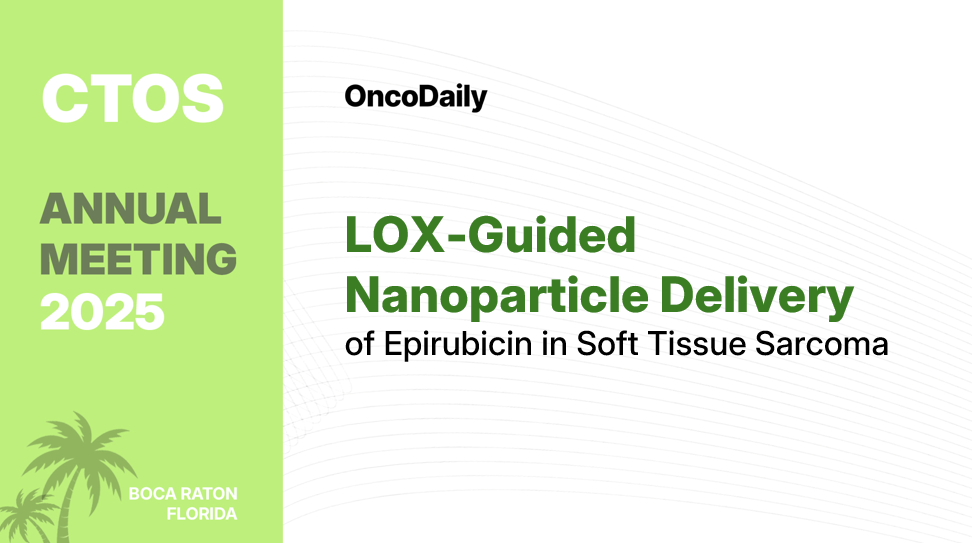LOX-Targeted Nanomedicine took center stage at the CTOS 2025 Annual Meeting, where new translational research highlighted a promising approach to improving drug delivery in metastatic soft tissue sarcomas (STS). These tumors remain difficult to treat, with standard anthracycline-based regimens offering limited benefit and substantial toxicity. To address this challenge, investigators focused on a defining feature of advanced sarcomas – the remodeled extracellular matrix enriched with lysyl oxidase (LOX) enzymes.
The team developed a LOX-targeted nanoparticle capable of delivering epirubicin directly into LOX-rich tumor regions. The approach aims to increase intratumoral drug concentration while minimizing off-target exposure, offering a potential path toward more effective and better-tolerated therapy.

Background
Metastatic soft tissue sarcomas remain difficult to manage, with anthracycline-based chemotherapy providing only limited benefit while exposing patients to considerable systemic toxicity. As treatment options plateau, efforts have increasingly focused on identifying features of the tumor microenvironment that could be used to improve drug delivery and therapeutic precision.
One of the most consistent characteristics of advanced sarcomas is the remodeling of the extracellular matrix (ECM), driven in part by the overexpression of lysyl oxidase (LOX) enzymes in both primary and metastatic lesions. LOX contributes to tumor progression and creates a distinct biological landscape that drugs can potentially target. This made LOX an attractive anchor for developing a nanoparticle system designed to deliver epirubicin directly into LOX-rich regions, with the goal of enhancing efficacy while reducing off-target toxicity.
Methods
The investigators engineered and patented a lipid-based nanoparticle (NP) functionalized with anti-LOX antibodies, termed Lipo-LOX. This platform was developed to deliver epirubicin (EPI) directly to tumor areas enriched with LOX.
Their experimental workflow included Nanoparticle Development and Characterization
Four formulations were produced:
- Lipo (base liposome)
- Lipo-LOX (LOX-targeted)
- Lipo-EPI (epirubicin-loaded)]
- Lipo-EPI-LOX (epirubicin + LOX-targeted).
These were evaluated using Dynamic Light Scattering (DLS), Nanoparticle Tracking Analysis (NTA) ,Encapsulation efficiency (EE%)All formulations showed stability in size, polydispersity index, zeta potential, and encapsulation.
Cell Models and Patient-Derived Cultures
Samples from 16 patients with soft tissue sarcoma (STS) were used to establish both immortalized cell lines and patient-derived primary cultures, creating a diverse and clinically relevant panel of models. These models, together with established sarcoma cell lines, were used to evaluate nanoparticle uptake, drug delivery efficiency, growth inhibition, and overall therapeutic performance.
- NP uptake
- Drug release
- Tumor targeting
- Growth inhibition
- Toxicity
Four concentrations were tested, ranging from the peak plasma concentration of epirubicin to 1/8 of that level, to reflect clinically relevant drug exposure.
Confocal microscopy was used to track nanoparticle localization and validate LOX-specific uptake.
Results
Across eight STS cell lines and patient-derived cultures, Lipo-EPI-LOX demonstrated the highest efficacy, even at the lowest tested dose (1/8 of peak EPI concentration).
Key findings include:
- Enhanced growth inhibition across 2D and 3D models
- Superior performance compared with non-targeted formulations
- Clear localization to LOX-rich regions on confocal imaging
These results suggest that LOX-targeting improves epirubicin delivery and may enhance therapeutic intensity while minimizing systemic exposure.
Conclusion
The study supports LOX-targeted nanoparticles as a promising new direction for managing advanced sarcomas. Instead of relying on tumor histology or specific molecular alterations, this strategy takes advantage of a shared microenvironmental feature — LOX overexpression within the extracellular matrix. By anchoring drug delivery to this ECM signature, the platform introduces a more universal method of targeting that may be applicable across multiple sarcoma subtypes.
These results offer a clear rationale for advancing the Lipo-LOX system toward clinical development. The ability of the LOX-targeted, epirubicin-loaded nanoparticle to demonstrate strong activity at a fraction of peak plasma drug concentrations suggests the potential for more effective treatment with reduced systemic toxicity. In a disease where traditional chemotherapy is constrained by limited efficacy and substantial side effects, a targeted delivery system such as this could represent a meaningful step toward safer, more precise therapy.
For more information click here.
